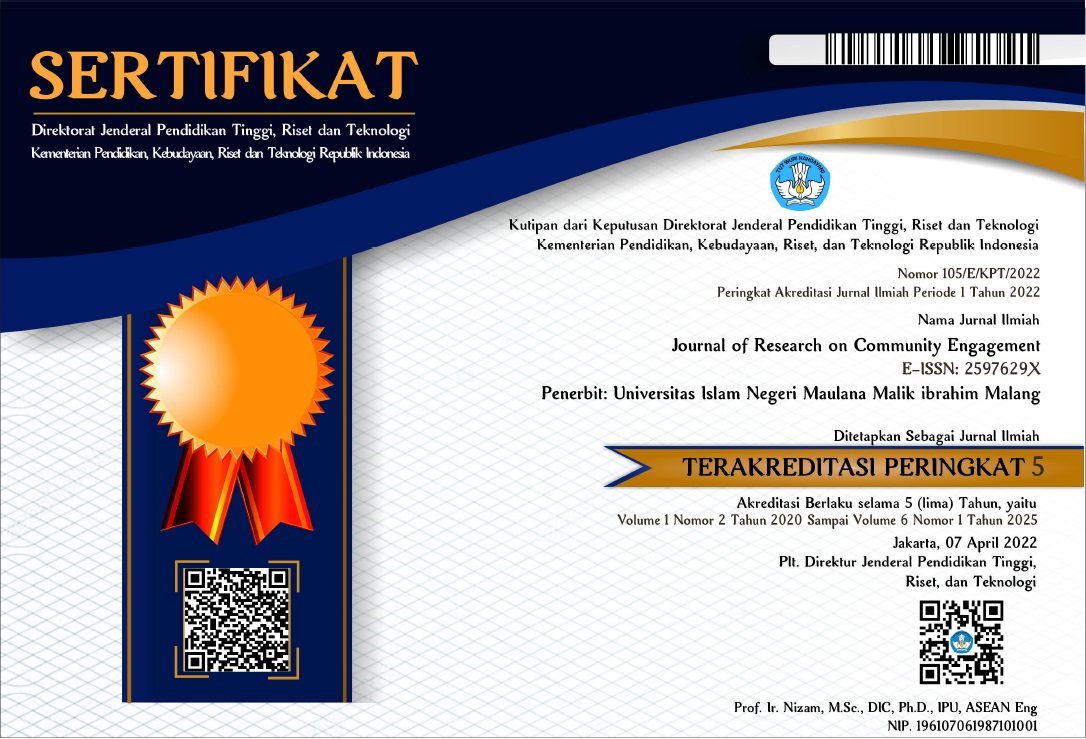UPAYA PENINGKATAN PENDAPATAN EKONOMI MASYARAKAT BAKALAN KRAJAN SECARA BERKELANJUTAN MELALUI EKSTENSIFIKASI PETERNAKAN JANGKRIK DAN DOMBA
Abstract
The potential of human resources and natural resources in the village of krajan will not be maximally exploited. Potential Human Resources include the ability of the community to work together in livestock business and Natural Resources including the availability of abundant forage forage in the rainy season. The use of fodder forage for sheep and cattle feed traditionally has not provided significant income for the community besides traditional maintenance will take a long time. Extensification of livestock business with income that can be generated in the short term is very urgent to do immediately. Cricket is a potential livestock business to be developed considering the relatively short production cycle of only 1 month while the fattening program or sheep fattening is also relatively short, which takes about 3 months to harvest. The construction of cricket cages and the expansion of sheep cages of joint business groups owned by the residents of krajan are expected to be able to increase community income both in the short term (1-3 months) or long term (annual). Community service using the active partition method has been successfully carried out with the following work programs; 1) cricket cage production capacity of 250 kg/month, 2) sheep fattening cages from a capacity of 30 heads to 80 heads, 3) training in making silage and ammoniation and complete feed for sheep, 4) improving the genetic quality of sheep by producing cempe and super sheep enlargement . The results of the first period cricket production trials were 31 kg (from 2 boxes) or 31-32 of the target (50 kg/box), the second trial produced 60 kg (of 2 boxes) or 60% of the target and the third trial produced 124 kg (from 4 boxes) or 62% of the target. The benefit gained in each period is Rp. 400,000/box per harvest. While the expansion of the sheep pen has an impact on investor interest in the investment of fattening rams so that the males for fattening, which originally came from only 2 to 30, have increased 15-fold to date. The increase in sheep population will potentially increase the income of Rp. 500,000/breeder/month or Rp. 100,000/head/month. The low yield of crickets from the target is caused by several factors, including seasonal changes and unstable feed sources and production management by farmers who lack discipline in feeding. Whereas in sheep, breeding and fattening systems face obstacles including the provision of alternative feed which cannot be implemented optimally due to the absence of copper or forage counters and fleece cutting machines. If the two tools are fulfilled the optimization of income from the sheep sector will be significantly increased.
Full Text:
PDFReferences
Algifari. 2011. Hubungan antara Pendapatan per Kapita dan Indeks Pembangunan Manusia. Jurnal Ekonomi dan Bisnis, Vol. 5, No3.
Bappenas 2012. Laporan Tahunan http://simpadu-pk.bappenas.go.id/ajax_datamart/download_file/49
Burm, G. 2000. Budidaya Ternak Jangkrik, 1–9. Proyek Pengembangan Ekonomi Masyarakat Pedesaan, Bappenas. Kantor Deputi Menegristek Bidang Pendayagunaan dan Pemasyarakatan Ilmu Pengetahuan dan Teknologi Gedung II BPP Teknologi
Delfianizar, S dan Kasmeri, R.. 2011. Pengaruh Campuran Pakan Bravo 511 Terhadap Pertumbuhan Jangkrik (Gryllus testaceus ). Program Studi Pendidikan Biologi, Sekolah Tinggi Keguruan Dan Ilmu Pendidikan STKIP PGRI Sumatera Barat.
Ndakularak, E., N.D. Setiawina, dan I.K. Djayastra. 2012. Analisis Faktor-Faktor Yang Mempengaruhi, Fakultas Ekonomi dan Bisnis Universitas Udayana (Unud), Bali, Indonesia. 140–153.
Nuraini, Fitria. 2014. Ka-Do (Kambing Domba) Untuk Peternakan Indonesia. Akses online di http://himasiter.lk.ipb.ac.id/files/2014/10/KA-DO-untuk-peternakan-indonesia.pdf
Tirtamulya, K., & Karawang, K. 2007. Optimasi Peran Ternak Domba Dalam Menunjang Usahatani Lahan Sawah, Lokakarya Nasional Sistem Pengembangan Integrasi Tani-Ternak, 17–21.Balai Pengkajian Teknologi Pertanian Jawa Barat
World Bank. 2014. Laporan Quartal Ekonomi Indonesia; Pilihan sulit. Akses online via http://www.worldbank.org/content/dam/Worldbank/document/EAP/Indonesia/IEQ-July14-BHS.pdf
Yulistiani, Tiesnamurti, B., Umi, A. dan Setiyanto, H.. 1998. Optimasi teknologi usaha ternak kambing dan domba sebagai upaya meningkatkan efisiensi usaha. Balai Penelitian Ternak, Liogor.
DOI: https://doi.org/10.18860/jrce.v1i1.4397
Refbacks
- There are currently no refbacks.
Copyright (c) 2019 Journal of Research on Community Engagement




.jpg)